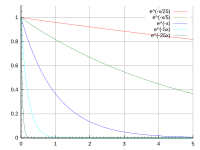Exponential decay

Exponential decay is a fancy term to describe how things decrease or get smaller over time, and it can be thought of as a kind of "reverse growth." Think about a toy balloon that is slowly losing air over time until it becomes completely deflated. This is an example of exponential decay.
When something experiences exponential decay, it starts off big and gradually gets smaller at a faster and faster rate. This happens because the rate of change is proportional to the remaining amount, meaning that as there is less and less of the thing, it falls apart faster and faster.
To understand this better, let's think about a pile of candy. You have a big pile of candy, and every minute, someone takes half of the remaining candy away. The first minute, someone takes half of the pile, which means they have half of what you started with. The next minute, someone takes half of that remaining pile, which means they have one quarter of the original pile. The third minute, someone takes half of the remaining candy again, which means they now have only one eighth of the original pile, and so on until there is no candy left.
This is what exponential decay looks like: a quick initial change followed by a slower and slower decrease as the thing becomes smaller and smaller.
When something experiences exponential decay, it starts off big and gradually gets smaller at a faster and faster rate. This happens because the rate of change is proportional to the remaining amount, meaning that as there is less and less of the thing, it falls apart faster and faster.
To understand this better, let's think about a pile of candy. You have a big pile of candy, and every minute, someone takes half of the remaining candy away. The first minute, someone takes half of the pile, which means they have half of what you started with. The next minute, someone takes half of that remaining pile, which means they have one quarter of the original pile. The third minute, someone takes half of the remaining candy again, which means they now have only one eighth of the original pile, and so on until there is no candy left.
This is what exponential decay looks like: a quick initial change followed by a slower and slower decrease as the thing becomes smaller and smaller.
Related topics others have asked about:
